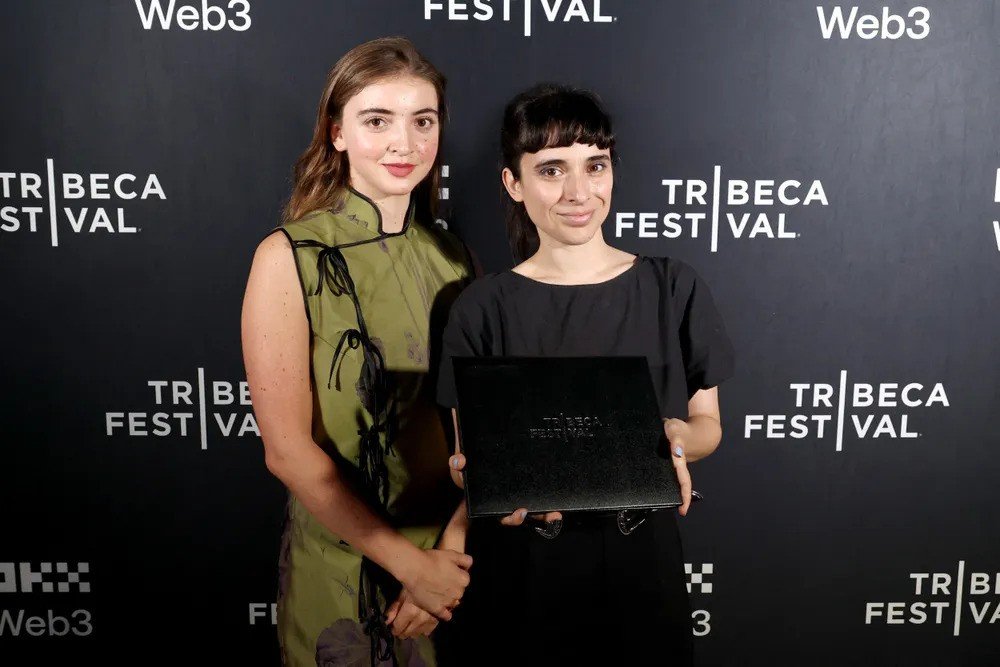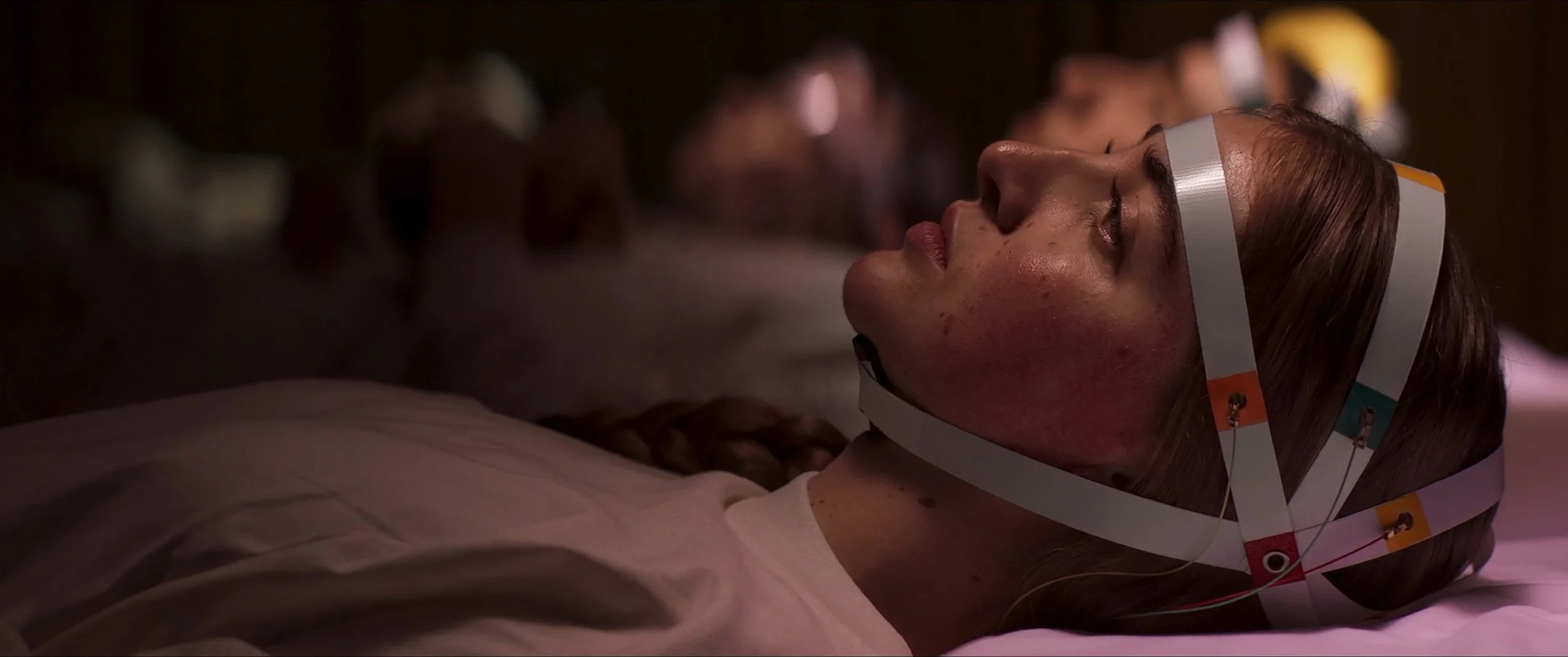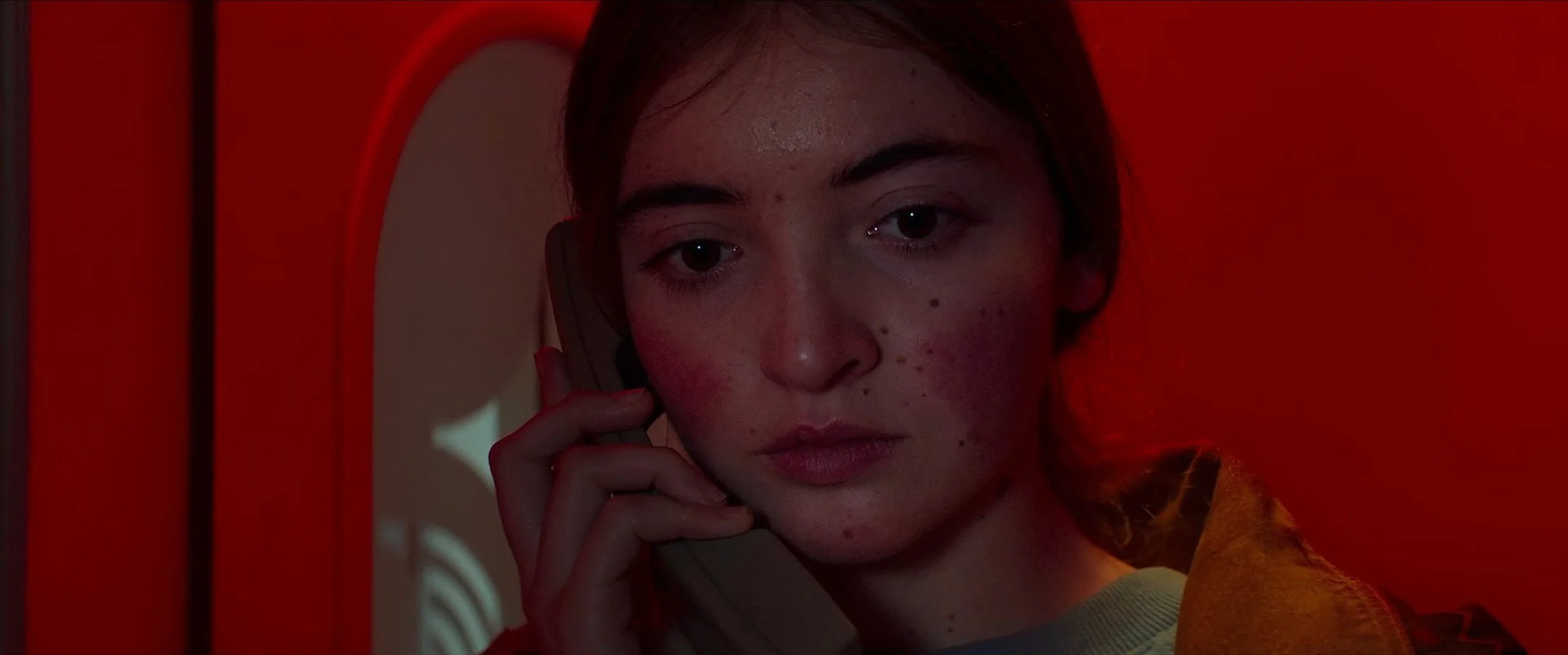By Natalia Hernández Moreno *
A boundary-pushing and visually arresting sci-fi drama, Uruguay's A Bright Future / Un futuro brillante, directed by Lucía Garibaldi, unfolds in a bleak, out-of-time South American neighborhood where large-scale fumigations are routine. It’s there that 18-year-old Elisa (newcomer Martina Passeggi in a breakthrough performance) is selected for a prestigious journey to the mysterious "North"—a distant promised land no one has ever returned from, including her older sister.
The most promising young people are sent to this mythical North, "history is being rewritten without mistakes." Elisa, the last young person in her community, is selected to go. Her mother, a devoted believer in the North, works double shifts to win a coveted travel auction. Elisa’s older sister was sent there before, and now their mother dreams of reuniting the three of them.
Yet, the arrival of Leonor, an enigmatic nurse with a prosthetic leg, disrupts the routine: Elisa discovers that her youth is a highly desired commodity, and new developments plant seeds of doubt in her. Refusing to become just another piece of the new order—even if her resistance makes her the most coveted of all—Elisa begins to question whether the North is truly salvation. But soon, she realizes she doesn’t want to leave—and that simply saying so is not enough.
With an outstanding ensemble cast featuring acclaimed actors Soledad Pelayo (The Freshly Cut Grass), Sofía Gala Castiglione (Alanis), and Alfonso Tort (The Freshly Cut Grass), A Bright Future creates a stylized reality not far from our own—where youth is currency, ants are malevolent, and dogs are extinct. Grounded in a deeply personal story, the dystopian yet rebelliously hopeful film explores intergenerational sacrifice and the definitive power of refusal.
Recent winner of the Viewpoints Section Award for its “seamless world that is captivating, thought-provoking, fresh and increasingly relevant. Weaving themes of the fetishization of youth, the timeless pursuit of dreams, and what makes us human, and anchored by a pitch perfect performance from their lead actress” (as quoted by the jury), A Bright Future is a bold leap forward for one of Latin America’s most distinctive filmmakers.
After its world premiere on June 5, I sat down with director Lucía Garibaldi and lead actress Martina Passeggi to talk about the film's ironic clarity, the choreographical intertwining of tactility and smell, and the power of suggestion involved in a playful directorial style.
How was the reception of the film at its world premiere at Village East? What do you make out of the first impressions of a New York audience?
Lucía Garibaldi (LG): One thing I know I will remember vividly is that people stood up to applaud once the film was over. That was exciting. I don't know if it always happens, but we really enjoyed it and we felt like they were laughing at the same things we were laughing at. I was very nervous because I feel it's a very specific film because of its strangeness. And I had my doubts about whether people would empathize with its humor. The film has elements of absurdity that don't usually translate well outside of our region, things that make sense to Uruguayans, but won't necessarily resonate with international audiences. The important thing is always to generate a reaction and it's interesting to see how something that is funny to you is impressive to someone else. The notion of the smell we explore in the story, which for me is very funny, may be read as uncanny by others.
For that, the premiere experience was very gratifying. And I feel that, here in New York, I have found great openness and empathy towards the film. It's like we feel the same.
Martina Passeggi (MP): Lucía and I were just talking about this yesterday: at one point there was a growing sense of communion at the film's premiere. To say that “we were all feeling the same” is a bit cliché, but I sensed a pact of the whole audience with the whole film that feels very special.
LG: Yes, we were all inside that world, beyond the darkness of the theater. The curators at Tribeca also deeply cared about the film. And from day one they made the effort to understand it and worked hard to highlight it. They gave us a place to test the story and fostered an enriching place for discussion and deeper questions after the screening. Above all, they dedicated time and love to it.
I quite agreed with one of an audience member who, by the end of the Q&A, replied to your mention of budget difficulties highlighting that they are not visible all in the final film. It all feels curated and strategically placed and framed. Could you expand a bit on the production process with Pancho (Magnou Arnábal) and Isabel (García)? And how did you all as a team work to put your vision to work?
LG: I feel all my filmmaker friends in Uruguay (and South America, by extension) can relate to this: you have an idea which you later have to translate to a shooting days schedule. There you realize you have two weeks of shooting less than you had planned. And you have to understand, from the beginning, that what you wanted to do in two six weeks you have to do in four. And you have to train your head to think the same with much less.
You don't always have the possibility to make the camera movements you want and you have to solve everything with a lot of skill. I was already prepared for that because everything is very DIY in Uruguay. So I'm not afraid of it and, on the contrary, I like the challenge. I also feel that at a certain point it makes sense to have to break your head thinking about an idea so as not to be overwhelmed in terms of budget. Sometimes it's delirious how much money is spent on productions.
So it's a matter of assuming your creative responsibility. In this case it was a big challenge because our story involved science fiction elements, where VFX are traditionally expensive. Mariano Santini, who did them for our film, is a genius, and with his time and effort he molded initial ideas into more feasible executions. It worked that we thought of narrating the dystopia through the habits of characters and the breakdown of traditions; through what they eat, through the seed that gives the north, through the absence of the dogs. They are simply ideas—and visually there is nothing too crazy. That makes it intimate and makes you focus on what happens to Elisa.
Now that you mention the play with habits, the script places a lot of emphasis on Elisa's process of adaptation before she embarks North. It's a process of adaptation, of course, that is teased through her percipience. Martina, how did you adapt, from your sensitivity as a dancer and choreographer, to your way of moving in space now that you enter into conversation with cinematic language?
Martina Passeggi: With respect to Elisa I feel it was a matter of understanding. After reading the script, the weight of the places and those glances on her penetrated all the time and a physicality that I can now see clearly was being woven. But in the beginning it was a matter of gradually building a body and a way of being in the world. There is always a lot of talk about the process of building the character in terms of the arc, but in my process with Lucía I understood that what called me most was to understand “how this living entity feels”. As if you were a mass and with all this context a new being is generated. A person is woven with an environment that makes you be in a way that paralyzes you, “que te para-Elisa”.
Involuntarily, I can relate to that feeling of having all eyes on me simply for holding the “treasure of youth”. To be a new artist is to live daily with that expectation of being the young promise.
With this fixation on the gaze, I am transfixed by the fact that scenes where choreography is the absolute highlight, Martina's dancing is not seen by the other characters on the screen (since they are blindfolded). All of Elisa's movement translates to another kind of sensorial notion, particularly olfactory. How did you both assemble this type of movement?
LG: I am quite fond of that scene. It was very exciting to film. Aside from assembling the choreography, we had to coordinate with the camera that was moving with her, as if they were dancing seamlessly. The camera moves, she appears, then she goes out, the camera goes back. It's a sequence shot of the whole first “odor” session.
For me it is great choreography between all of us. I remember that we managed to capture it while our crew was figuring out lighting on set. We made up the choreography as we were talking and Martina memorized it and mechanized it in two seconds. There was a very good connection.
MP: I always read that scene as a kind of offering. I remember rehearsing and memorizing Elisa's movements by beats and their respective smells so that the camera could register it well. And it was similar to what happened with a scene in which I do a backwards cambré.
LG: I always said: “I have to take advantage of Martina who can do anything with her body”. The videos I saw in the audition process caught my attention because of her ability to move in an unnatural way. And of course it's a great tool when, as a director, I want to see new things. We then took advantage of a sequence where Elisa's character is drunk to do anything that generates weirdness. And that movement came up.
Did the first version of the script anticipate any kind of movements? Or were they all adapted and formulated in media res?
Lucía Garibaldi: We figured them out right there in the set. It was all very intuitive. I had a nine-month-old baby in the middle of the shoot. So my time to think was during the shooting, in situ. Many things I couldn't think about before: I didn't have time. But I was very accompanied in the sense of solving things on the spot by Arauco Hernández, our director of photography, who has a very agile handling of staging and knows perfectly how and where to place the camera. It's very nourishing to work with people who have so much experience. Martina, on the other hand, had no audiovisual experience, but she had stage experience.
MP: Thanks to dance, I'm used to working collaboratively. So, for me, it was never a question of working on the character on my own. Everything always goes together, thinking and sharing.
LG: Exactly. It was all very collaborative. Multiple perspectives that combined very well. And we were very lucky as well. Having had a life or death experience (the back-and-forth between the pandemic and entering motherhood) makes you play a lot more, operating in a less carefree way. It allowed me to realize that, at a certain point, nothing is that important. We all started to feel that lightness on the set.
That playfulness translates very aptly to your directorial eye. I recently re-watched The Sharks and I'm fascinated by the adaptation of your own play with olfactory and tactile sensibility. They get twisted and sharpened. In this new world, sensations have sound and colors have scents. Could you expand on that process of translating playfulness from page to direction?
LG: That is a great way to word it. Directing is something that fulfills me like nothing else in the world and unfortunately I do very little of it. I would love to direct a film every year. So because it takes so long to get the space to do it, there is time to devote to curating it and I want to take care of all the details when it comes to doing it. I feel so lucky and that's why I always strive to have a good time and be in my place in the most playful way possible.
From past experience working on unnecessarily chaotic sets I know the stress that directing can bring. But I feel that it's in the film's best interest, this one in particular, to create a fun atmosphere because even at the most practical and economical level of production, it makes the shoot flow better. Actors, in the end, work with emotions. That's why it's my job to guarantee a calmness that allows them to build. I couldn't work with someone I can't have a beer with, I couldn't choose a lead actress with someone I can't be friends with. I always try to generate a bond of trust given the time we will spend together. And because film is an extension of life.
MP: I don't know who I was telling yesterday that the whole shoot felt very organic and we never said out loud, “what an effort and hard work to do this.” There was always that web of trust woven. And now, looking back on it, I only think of the fortune of working from that complicity. Without it, I would feel supremely naked and vulnerable.
Finally, is there anything in the reception or in the experience of seeing the film being born that has generated strangeness?
LG: I find it very funny that people get angry that I don't show the North. Or at least that they want to know more about what goes on in that world.
There is also a political aspect to what is said, which we all imagine and take for granted. For me, it is a very conscious decision not to show the North, because I just want to emphasize that nobody has the slightest idea of what it is. That it is a construction of what is talked about, of the handling of information in the world. How in a place we yearn for something without wanting to know what it is.
MP: Or that we all know what it is, too. And for that there is no need to show it.
And there lies the richness of building an imaginary strategically without visuals, in suggestion.
LG: Precisely! The construction of an imaginary, of an ideal, of abstract categories that we have interiorized.
MP: I feel that also this film is not about the device, it is the story of Elisa and her life in the South.
And in the end the gratifying thing is that, in this spatial game, the South becomes her North. Very much à la Joaquín Torres García.
LG: Exactly! There was, in fact, a scene we took out where she turns a map with a compass and the North is in the South. And that echo was always there. We just decided to leave it, just as you say, to suggestion. Someone who was very key in that choice was Sebastián Schjaer (director of The Omission / La Omisión and frequent editor of Matías Piñeiro's films). He was always there measuring the construction of information and thinking a lot by my side. The most important decisions were made under his suggestion, in the sense of how much to say, how much to tell, how much not to tell. As in any editing process. But Seb, in particular, was very active and very insightful in advising me.
The whole team, in general, was key. From the very beginnings of production to post. I feel incredibly fortunate to have assembled such an incredible team filled with Uruguay's very best. And it is now the greatest gift to show it to new audiences that progressively become more acquainted with our cinema(s).
*Natalia Hernández Moreno is a researcher and Outreach Coordinator for Cinema Tropical – and frequent collaborator for TropicalFRONT.









